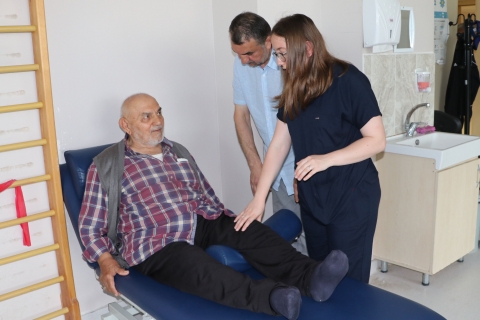OMU hosts symposium on AI-supported neonatal movement analysis in high-risk infants
Ondokuz Mayıs University (OMU) Faculty of Medicine, Department of Neonatology, and the OMU Developmental Education Application and Research Center (OGEM) jointly organized a symposium titled “Early Diagnosis and Intervention in High-Risk Infants Using Artificial Intelligence.”
Held at the Samsun Metropolitan Municipality Ömer Halisdemir Multi-Purpose Hall, the event explored current advances in health technologies, focusing on AI-supported methods for detecting diseases in infants before they progress and improving early intervention opportunities.
Opening remarks highlight the needs of high-risk infants
Samsun Medical Chamber President Prof. Dr. Canan Seren delivered the opening speech, offering evaluations on issues related to high-risk infants.
AI-based neonatal movement analysis system introduced
Lecturer Dr. Sema Gül, Academic Advisor for the OGEM Neonatal Intensive Care Unit, presented the artificial intelligence–based application she developed, which analyzes the movements of newborns to contribute to the early diagnosis of neurological disorders.
Gül emphasized significant advances in AI, particularly in imaging-based diagnostic processes:
“AI models have rapidly progressed in fields such as radiology, pathology, and histology. Health professionals can reach diagnoses much faster with the support of these models. AI not only facilitates early diagnosis but also reduces the risk of incorrect intervention.”
“Worldwide, the rate of high-risk infants reaches 10 percent”
Gül noted that approximately 100,000 babies are born prematurely each year in Türkiye and that globally, around 10 percent of infants fall into the high-risk category. She also pointed out that premature birth rates in Samsun are higher than in many other provinces:
“Early diagnosis is critical for reducing the lifelong risks these babies may face. Infants discharged from neonatal intensive care must be monitored closely for developmental progress.”
Explaining the aim behind the AI-based “high-risk infant movement detection” application, Gül stated that the goal is to support diagnosis at an even earlier stage. Drawing on her experience in neonatal intensive care, she described how she analyzed videos sent by families to assess infants’ neurodevelopmental status and guide them accordingly.
Gül added that international studies have already shown the feasibility of analyzing infants’ general movements using AI, and highlighted that academic publications on artificial intelligence in pediatrics have risen notably since 2014–2016.
Additional academic presentations
The symposium also featured presentations on:
• “Early Diagnosis in High-Risk Infants Using Artificial Intelligence”
• “Enteral Feeding Problems and Solutions”
• “Behavioral Interventions, Home Environment Quality, and Developmental Risks in High-Risk Infants”


















